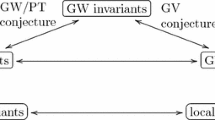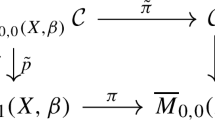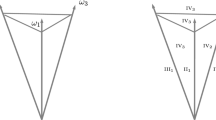Abstract
Motivated by S-duality modularity conjectures in string theory, we define new invariants counting a restricted class of two-dimensional torsion sheaves, enumerating pairs \(Z\subset H\) in a Calabi–Yau threefold \(X\). Here \(H\) is a member of a sufficiently positive linear system and \(Z\) is a one-dimensional subscheme of it. The associated sheaf is the ideal sheaf of \(Z\subset H\), pushed forward to \(X\) and considered as a certain Joyce–Song pair in the derived category of \(X\). We express these invariants in terms of the MNOP invariants of \(X\).
Similar content being viewed by others
Notes
We use straight \(I\)s to denote ideal sheaves on \(H\) and curly \(\mathcal {I}\)s for ideal sheaves on \(X\).
Isomorphism is meant in the strict sense: two families of stable pairs \((\mathcal {E}_i,s_i)\) are isomorphic if there is an isomorphism \(\mathcal {E}_1\rightarrow \mathcal {E}_2\) taking \(s_1\) to \(s_2\). Stable pairs have no automorphisms so there is no need to tensor by line bundles pulled back from the base (as one does to define isomorphism for families of stable sheaves, for example: stable sheaves have Aut \(=\mathbb {C}^*\)).
In fact it is all of \(M_{c}(X)\) when \(H^2(X,\mathbb {Z})\) is torsion-free.
For instance this is the case when all members of the linear system \(|H|\) are reduced and irreducible. The hyperplane sections of the quintic threefold have this property by the Lefschetz hyperplane theorem.
In [15] Toda studies some different but remarkable wall crossings. These relate the counting of torsion sheaves to the counting of both ideal sheaves [11] and stable pairs [13]. There may be some connection: a hint is provided by the fact that Fujita’s conjecture (which would determine which \(H\) are sufficiently positive in the sense of Definition 2.2) enters into his analysis. Manschot [10] also studies another wall crossing involving these invariants.
References
Behrend, K.: Donaldson–Thomas invariants via microlocal geometry. Ann. Math. 170, 1307–1338 (2009)
Cheng, M., DeBoer, J., Dijkgraaf, R., Manschot, J., Verlinde, E.: A farey tail for attractor black holes. J. High Energy Phys. 2006(11), 1–28 (2006)
Denef, F., Moore, G.: Split states, entropy enigmas, holes and halos. J. High Energy Phys. 2011(11), 1–152 (2011)
Gaiotto, D., Strominger, A., Yin, X.: The M5-Brane elliptic genus: modularity and BPS states. J. High Energy Phys. 2007(8), 1–18 (2007)
Gaiotto, D., Yin, X.: Examples of M5-Brane elliptic genera. J. High Energy Phys. 2007(11), 1–12 (2007)
Huybrechts, D., Thomas, R.P.: Deformation-obstruction theory for complexes via Atiyah and Kodaira–Spencer classes. Math. Ann. 346(3), 545–569 (2010)
Joyce, D., Song, Y.: A theory of generalized Donaldson–Thomas invariants. Memoirs AMS 217(1020), iv+199 (2011). ISBN 978-0-8218-5279-8
Kollár, J.: Projectivity of complete moduli. J. Differ. Geom. 32, 235–268 (1990)
Maldacena, J., Strominger, A., Witten, E.: Black hole entropy in M-theory. J. High Energy Phys. 1997(12), 1–16 (1997)
Manschot, J.: Wall-crossing of D4-branes using flow trees. Adv. Theor. Math. Phys. 15(1), 1–42 (2011)
Maulik, D., Nekrasov, N., Okounkov, A., Pandharipande, R.: Gromov–Witten theory and Donaldson–Thomas theory. I. Compos. Math. 11, 1263–1285 (2006)
Ooguri, H., Strominger, A., Vafa, C.: Black hole attractors and the topological string. Phys. Rev. D 70(10), 106–119 (2001)
Pandharipande, R., Thomas, R.P.: Curve counting via stable pairs in the derived category. Invent. Math. 178, 407–447 (2009)
Thomas, R.P.: A holomorphic Casson invariant for Calabi–Yau 3-folds, and bundles on K3 fibrations. J. Differ. Geom. 54, 367–438 (2000)
Toda, Y.: Bogomolov–Gieseker type inequality and counting invariants. J. Topol. 6(1), 217–250 (2013)
Acknowledgments
We thank Kai Behrend, Vincent Bouchard, Jim Bryan, Tudor Dimofte, Dagan Karp, Jan Manschot, Davesh Maulik and Yukinobu Toda for useful discussions. The second author would like to thank the University of British Columbia, the Max Planck Institute, Bonn and the Isaac Newton Institute for Mathematical Sciences, Cambridge for their hospitality. The third author is supported by the EPSRC programme Grant EP/G06170X/1.
Author information
Authors and Affiliations
Corresponding author
Rights and permissions
About this article
Cite this article
Gholampour, A., Sheshmani, A. & Thomas, R. Counting curves on surfaces in Calabi–Yau 3-folds. Math. Ann. 360, 67–78 (2014). https://doi.org/10.1007/s00208-014-1035-5
Received:
Revised:
Published:
Issue Date:
DOI: https://doi.org/10.1007/s00208-014-1035-5




